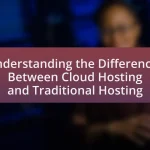Migrating your website to a dedicated server involves a systematic process that includes planning, data backup, server setup, data transfer, and testing. This transition is often pursued for enhanced performance, improved security, and greater control over resources compared to shared hosting. Key advantages of dedicated servers include the ability to handle higher traffic volumes, advanced security features, and tailored server configurations. The article outlines essential steps for migration, preparation techniques, tools needed, potential challenges, and best practices to ensure a successful transition while minimizing downtime and maintaining website functionality. Additionally, it addresses post-migration considerations such as performance optimization and ongoing maintenance to ensure the server operates efficiently and securely.
What is Involved in Migrating Your Website to a Dedicated Server?
Migrating your website to a dedicated server involves several key steps, including planning, data backup, server setup, data transfer, and testing. First, planning is essential to determine the requirements of the dedicated server, such as hardware specifications and software configurations. Next, backing up all website data ensures that no information is lost during the migration process. After securing the data, the dedicated server must be set up, which includes installing the necessary operating system and software. Following the setup, transferring the website files and databases to the new server is crucial, often utilizing FTP or other transfer protocols. Finally, testing the website on the dedicated server is necessary to confirm that all functionalities work correctly before updating DNS settings to point to the new server. Each of these steps is critical to ensure a smooth and successful migration.
Why would you consider migrating to a dedicated server?
Migrating to a dedicated server is considered for enhanced performance and control over resources. Dedicated servers provide exclusive access to hardware, which significantly improves website speed and reliability, especially for high-traffic sites. According to a study by HostingAdvice, dedicated servers can handle up to 10 times more traffic than shared hosting, ensuring that your website remains responsive during peak times. Additionally, dedicated servers offer greater security features, reducing the risk of data breaches and ensuring compliance with regulations.
What are the key advantages of using a dedicated server?
The key advantages of using a dedicated server include enhanced performance, improved security, and greater control over server resources. Dedicated servers provide exclusive access to all hardware resources, which leads to faster load times and better handling of high traffic volumes. Additionally, they offer advanced security features, such as custom firewalls and dedicated IP addresses, reducing the risk of cyber threats. Furthermore, users have full control over server configurations, allowing for tailored setups that meet specific application requirements. These benefits make dedicated servers a preferred choice for businesses with demanding hosting needs.
How does a dedicated server differ from shared hosting?
A dedicated server provides exclusive resources to a single user or organization, while shared hosting allocates resources among multiple users on the same server. In dedicated hosting, the user has full control over the server’s configuration, performance, and security, which is crucial for high-traffic websites or applications requiring significant resources. In contrast, shared hosting is more cost-effective but can lead to slower performance and security vulnerabilities due to resource sharing. According to a 2021 study by HostingAdvice, dedicated servers can handle significantly higher traffic loads compared to shared hosting, making them a better choice for businesses with growing demands.
What are the essential steps in the migration process?
The essential steps in the migration process to a dedicated server include planning, backing up data, setting up the new server, transferring files, updating DNS settings, and testing the new environment.
Planning involves assessing the current website’s requirements and determining the necessary resources on the dedicated server. Backing up data ensures that all website files, databases, and configurations are securely saved before migration. Setting up the new server includes installing the required software and configuring server settings to match the previous environment. Transferring files involves moving website content and databases from the old server to the new one, often using FTP or SSH protocols. Updating DNS settings is crucial for directing traffic to the new server, which may involve changing A records or nameservers. Finally, testing the new environment ensures that the website functions correctly and that all features are operational before fully switching over.
How do you prepare your website for migration?
To prepare your website for migration, conduct a comprehensive backup of all website files and databases. This ensures that you have a complete copy of your current site, which is crucial for restoring it in case of any issues during the migration process. Additionally, audit your website for broken links, outdated content, and any necessary updates to ensure a smooth transition. According to a study by the Content Marketing Institute, 70% of website migrations fail due to inadequate preparation, highlighting the importance of thorough planning and execution.
What tools and resources are needed for a successful migration?
For a successful migration to a dedicated server, essential tools and resources include a reliable backup solution, a migration plugin or software, and access to server management tools. A reliable backup solution ensures that all website data is securely stored before migration, minimizing the risk of data loss. Migration plugins or software streamline the transfer process, allowing for efficient movement of files and databases. Access to server management tools is crucial for configuring the new server environment and ensuring optimal performance post-migration. These components collectively facilitate a smooth transition to a dedicated server, reducing downtime and maintaining data integrity.
What challenges might you face during the migration?
During the migration to a dedicated server, you might face challenges such as data loss, downtime, and compatibility issues. Data loss can occur if backups are not properly managed or if there are errors during the transfer process. Downtime may result from the time taken to switch servers, which can affect website availability and user experience. Compatibility issues can arise if the new server environment differs from the previous one, potentially leading to software or application failures. These challenges are common in server migrations and require careful planning and execution to mitigate risks.
How can you minimize downtime during the migration?
To minimize downtime during migration, implement a phased migration strategy. This approach allows for the gradual transfer of data and services, reducing the risk of complete service interruption. For example, by migrating non-critical components first, you can ensure that essential services remain operational while the migration progresses. Additionally, utilizing a staging environment for testing before the final switch can identify potential issues without affecting the live site. According to a study by the International Journal of Information Management, phased migrations can reduce downtime by up to 50% compared to traditional methods.
What are common issues that arise during the migration process?
Common issues that arise during the migration process include data loss, downtime, and compatibility problems. Data loss can occur if backups are not properly managed or if files are corrupted during transfer. Downtime may happen due to misconfigurations or server unavailability, impacting user access. Compatibility problems often arise when the new server environment differs from the old one, leading to software or application failures. These issues highlight the importance of thorough planning and testing before executing a migration to ensure a smooth transition.
How Do You Execute the Migration to a Dedicated Server?
To execute the migration to a dedicated server, first, back up all website data, including files and databases, to ensure no information is lost during the process. Next, set up the dedicated server environment by installing the necessary software, such as the operating system, web server, and database management system. After the server is configured, transfer the backed-up files and databases to the dedicated server using secure file transfer protocols like SFTP or SCP. Finally, update the domain’s DNS settings to point to the new server’s IP address, and test the website thoroughly to confirm that everything is functioning correctly. This methodical approach minimizes downtime and ensures a smooth transition to the dedicated server.
What are the best practices for migrating your website?
The best practices for migrating your website include thorough planning, creating a backup, testing the new environment, updating DNS settings, and monitoring performance post-migration. Thorough planning ensures that all aspects of the migration are considered, including potential downtime and data integrity. Creating a backup protects against data loss during the transition. Testing the new environment allows for the identification of issues before going live. Updating DNS settings is crucial for directing traffic to the new server, and monitoring performance post-migration helps in addressing any unforeseen problems quickly. These practices are essential for a smooth and successful website migration.
How do you back up your website before migration?
To back up your website before migration, use a reliable backup plugin or tool to create a complete copy of your website files and database. This process typically involves selecting a backup solution, configuring it to include all necessary files (such as themes, plugins, and media), and ensuring the database is also backed up, which contains all your content and settings. For example, popular plugins like UpdraftPlus or BackupBuddy can automate this process, allowing you to store backups on cloud services like Google Drive or Dropbox. This method ensures that you have a secure and accessible copy of your website, which is crucial for restoring it in case of any issues during migration.
What steps should you follow to transfer your files and databases?
To transfer your files and databases, follow these steps: First, back up all your website files and databases to ensure data integrity. Use FTP software like FileZilla to download files from your current server to your local machine. For databases, export them using tools like phpMyAdmin or command-line utilities, creating SQL dump files. Next, connect to your new dedicated server via FTP and upload the files to the appropriate directory. For databases, create a new database on the dedicated server and import the SQL dump files using phpMyAdmin or command-line tools. Finally, update your configuration files to reflect the new database connection details and test your website to ensure everything is functioning correctly.
How do you configure your new dedicated server?
To configure your new dedicated server, first, access the server’s control panel or terminal using SSH. Next, update the server’s operating system and install necessary software packages, such as a web server (e.g., Apache or Nginx), database server (e.g., MySQL or PostgreSQL), and any required programming languages or frameworks. After that, configure the firewall settings to secure the server and set up user accounts with appropriate permissions. Finally, test the server configuration by deploying a sample website or application to ensure everything is functioning correctly. This process is essential for optimizing performance and security, as evidenced by industry best practices that recommend regular updates and proper configuration for dedicated servers.
What settings need to be adjusted after migration?
After migration to a dedicated server, the settings that need to be adjusted include DNS settings, database connection configurations, and server security settings. DNS settings must be updated to point to the new server’s IP address to ensure proper domain resolution. Database connection configurations should be modified to reflect the new database server details, including host, username, and password. Additionally, server security settings, such as firewall rules and access permissions, need to be reviewed and adjusted to align with the new server environment, ensuring that only authorized users and services can access the server.
How do you ensure security on your new server?
To ensure security on a new server, implement a multi-layered security approach that includes firewalls, regular software updates, and strong authentication protocols. Firewalls act as a barrier between the server and potential threats, while regular updates patch vulnerabilities in the operating system and applications, reducing the risk of exploitation. Strong authentication protocols, such as two-factor authentication, enhance access control by requiring additional verification beyond just a password. According to a 2021 report by Cybersecurity Ventures, 60% of small businesses that experience a cyber attack go out of business within six months, highlighting the critical importance of robust security measures.
What post-migration tasks should you complete?
After migrating your website to a dedicated server, you should complete several essential post-migration tasks. These tasks include verifying website functionality, updating DNS settings, checking for broken links, optimizing performance, and ensuring security measures are in place. Verifying website functionality ensures that all features work correctly after migration, while updating DNS settings directs traffic to the new server. Checking for broken links helps maintain user experience and SEO rankings. Optimizing performance involves assessing load times and server response, which can be done using tools like Google PageSpeed Insights. Lastly, implementing security measures, such as configuring firewalls and SSL certificates, protects your website from potential threats.
How do you test your website after migration?
To test your website after migration, conduct a series of checks including functionality, performance, and SEO validation. First, verify that all links, forms, and interactive elements work correctly, ensuring that user experience remains intact. Next, assess the website’s loading speed using tools like Google PageSpeed Insights, as performance can be affected by server changes. Finally, check for any SEO issues, such as broken links or missing metadata, using tools like Screaming Frog SEO Spider. These steps confirm that the migration was successful and that the website operates as intended.
What monitoring tools can help you track performance post-migration?
Monitoring tools that can help track performance post-migration include Google Analytics, New Relic, and Datadog. Google Analytics provides insights into user behavior and traffic patterns, allowing for the assessment of website performance after migration. New Relic offers application performance monitoring, enabling users to track server response times and application errors, which is crucial for identifying issues that may arise post-migration. Datadog integrates with various services to monitor infrastructure and application performance, providing real-time visibility into system health and performance metrics. These tools collectively ensure that any performance issues can be quickly identified and addressed following a migration to a dedicated server.
What Should You Consider After Migrating to a Dedicated Server?
After migrating to a dedicated server, you should consider optimizing server configurations for performance and security. This includes adjusting settings such as memory allocation, CPU usage, and firewall rules to ensure the server operates efficiently and securely. Additionally, monitoring server performance through tools like uptime monitoring and resource usage analytics is crucial for identifying potential issues early. Regular backups and updates to software and security protocols are also essential to maintain data integrity and protect against vulnerabilities. These practices are supported by industry standards, which emphasize the importance of proactive server management to enhance reliability and security.
How can you optimize your website on a dedicated server?
To optimize your website on a dedicated server, implement server configuration adjustments, optimize resource allocation, and enhance security measures. Configuring the server involves adjusting settings such as PHP and MySQL to match your website’s specific needs, which can improve performance. Resource allocation can be optimized by using caching mechanisms like Varnish or Redis, which reduce load times by storing frequently accessed data in memory. Additionally, enhancing security through firewalls, SSL certificates, and regular updates protects your website from vulnerabilities, ensuring a stable and efficient environment. These strategies collectively lead to improved website performance and user experience.
What performance enhancements can be implemented?
Performance enhancements that can be implemented during a migration to a dedicated server include optimizing server configurations, utilizing caching mechanisms, and upgrading hardware components. Optimizing server configurations involves adjusting settings such as memory allocation and CPU usage to maximize resource efficiency. Implementing caching mechanisms, like Varnish or Redis, can significantly reduce load times by storing frequently accessed data. Upgrading hardware components, such as increasing RAM or switching to SSDs, can improve data retrieval speeds and overall server responsiveness. These enhancements lead to improved website performance, reduced latency, and a better user experience.
How do you manage server resources effectively?
To manage server resources effectively, implement resource monitoring and optimization techniques. Utilizing tools like Nagios or Zabbix allows for real-time tracking of CPU, memory, and disk usage, enabling proactive adjustments to resource allocation. Additionally, employing load balancing distributes traffic evenly across servers, preventing any single server from becoming a bottleneck. According to a study by Gartner, organizations that utilize resource management tools can improve server utilization rates by up to 30%, demonstrating the effectiveness of these strategies in optimizing server performance.
What ongoing maintenance is required for a dedicated server?
Ongoing maintenance for a dedicated server includes regular software updates, hardware monitoring, security management, and data backups. Regular software updates ensure that the operating system and applications are up-to-date, which helps protect against vulnerabilities. Hardware monitoring involves checking the performance and health of components like CPU, RAM, and storage to prevent failures. Security management includes implementing firewalls, intrusion detection systems, and regular security audits to safeguard against threats. Data backups are essential for recovery in case of data loss, and they should be performed consistently to ensure data integrity.
How often should you update your server software?
You should update your server software at least once a month. Regular updates are crucial for maintaining security, performance, and compatibility with new technologies. According to the Cybersecurity & Infrastructure Security Agency (CISA), timely updates can significantly reduce vulnerabilities that could be exploited by attackers. Additionally, many software vendors release patches and updates frequently, making it essential to stay current to protect your server from potential threats.
What security measures should be regularly reviewed?
Regularly reviewing access controls is essential for maintaining website security during a migration to a dedicated server. Access controls determine who can view or modify data and settings, and ensuring they are up-to-date helps prevent unauthorized access. Additionally, reviewing firewall configurations is crucial, as they protect the server from external threats by filtering incoming and outgoing traffic based on predetermined security rules. Regular updates to antivirus and anti-malware software are also necessary to defend against evolving threats. Lastly, reviewing backup procedures ensures that data can be restored in case of a security breach or data loss, maintaining the integrity and availability of the website.
What are some common troubleshooting tips for post-migration issues?
Common troubleshooting tips for post-migration issues include checking DNS settings, verifying file permissions, and ensuring database connections are correctly configured. DNS settings should point to the new server’s IP address to avoid accessibility issues. File permissions must be set correctly to allow the web server to read and execute files, which is crucial for website functionality. Additionally, confirming that the database connection strings in the configuration files match the new server’s database credentials is essential to prevent errors in data retrieval. These steps help identify and resolve common problems encountered after migrating a website to a dedicated server.
How do you resolve connectivity problems after migration?
To resolve connectivity problems after migration, first verify the DNS settings to ensure they point to the new server’s IP address. Incorrect DNS configurations are a common cause of connectivity issues post-migration. Next, check the firewall settings on the new server to confirm that they allow traffic on necessary ports, such as HTTP (port 80) and HTTPS (port 443). Additionally, ensure that the server’s network configuration is correct, including subnet masks and gateway settings. Finally, test the connectivity using tools like ping and traceroute to identify where the connection fails. These steps are essential as they address the most frequent causes of connectivity problems after a website migration.
What steps can you take if your website is not loading correctly?
If your website is not loading correctly, first check your internet connection to ensure it is stable and functioning. Next, clear your browser cache and cookies, as corrupted data can prevent proper loading. If the issue persists, verify that your web hosting server is operational by checking its status or contacting support. Additionally, inspect your website’s code for errors, as broken scripts or plugins can hinder loading. Finally, consider optimizing your website’s performance by reducing image sizes and minimizing HTTP requests, which can improve loading times.










